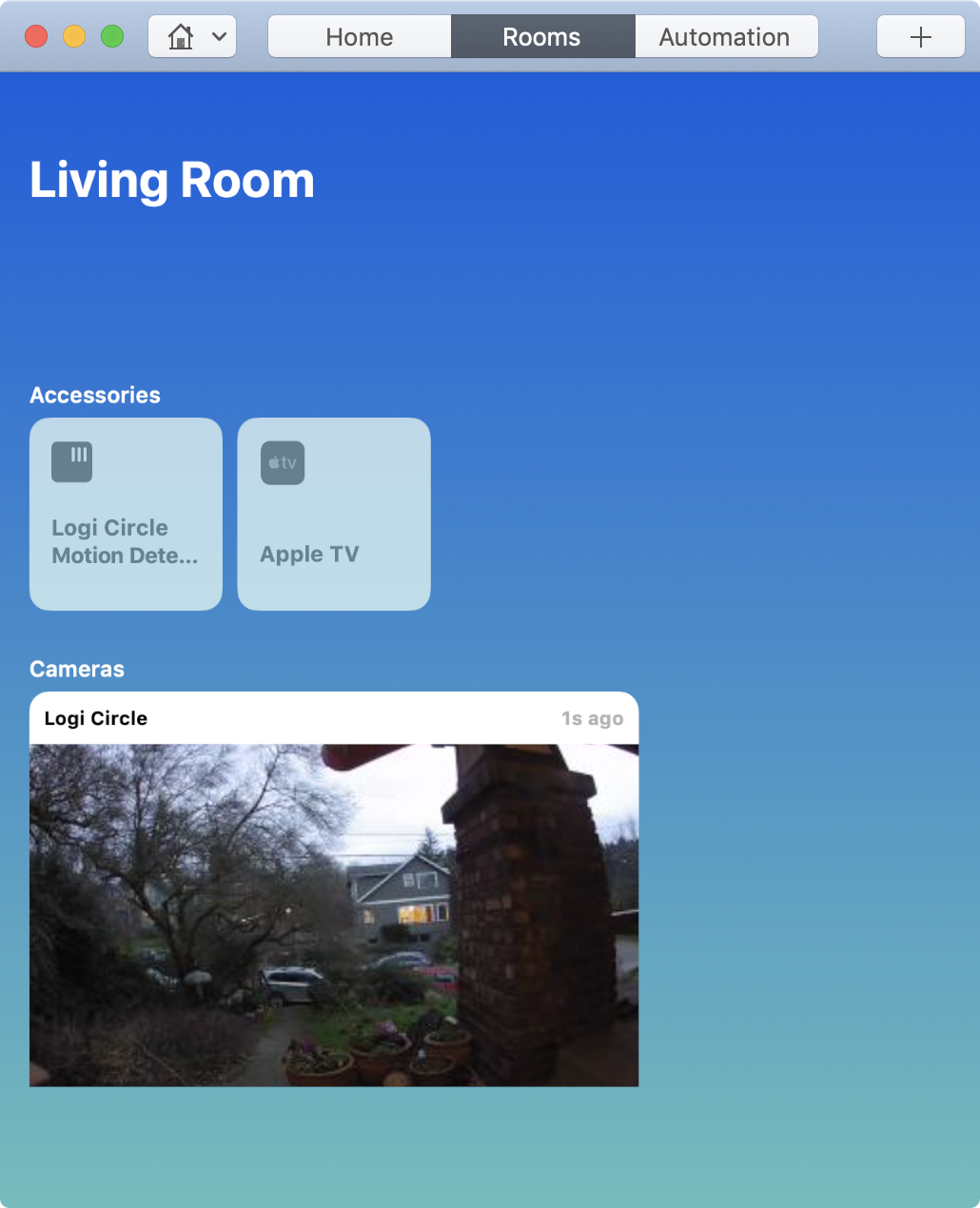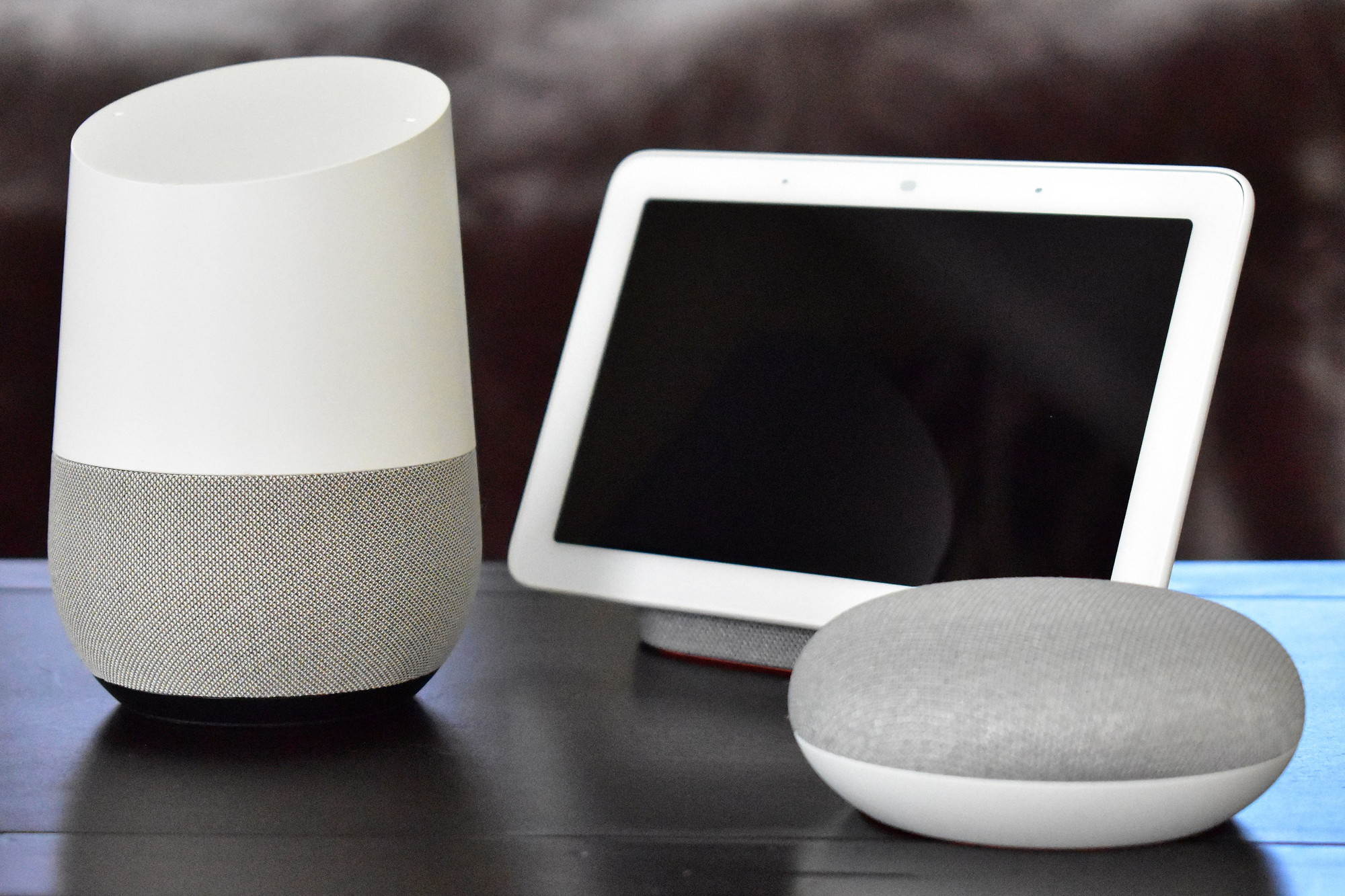Use Smart Home Ecosystems for Control
Many cameras work within an ecosystem of devices, like smart switches, bulbs, sensors, alarms, and more. There are ever more of these systems, some of which are particular to one company and some open to all hardware manufacturers.
These systems typically let you not just control devices individually, such as turning a switch off and on with a tap or viewing the streaming feed from a camera, but also group devices together and schedule them. This can let you create a living room group to turn lights and your A/V system on or off with one virtual switch.
You might also want your furnace to kick in at 5 P.M. if it’s below 68° F (20° C), have the front light and front walk’s lights turn on, and start music playing. Or you might want a trigger from a camera system to flip on flood lights and play Cher’s “Believe” at high volume through exterior speakers. (“Do you believe in life after love!”)
There are also ecosystems that allow voice control of cameras and other smart-home items via apps, smart speakers, smartphones, tablets, and computers. This chapter looks at all kinds.
What Kind of Systems Exist
In nearly every case, you have access to a camera’s functions via dedicated apps on multiple platforms and a web app. The ecosystem support is typically on top of that. A few manufacturers use a single app for all their devices, whether or not you are controlling them in groups or via timed or triggered actions.
Cameras can be found that also work within several kinds of ecosystems, which break out roughly into three categories:
Proprietary company standard: The company has its own ecosystem, but it’s not open to third parties. You can use smartphone/tablet apps and a web app (and sometimes desktop apps) to manage cameras along with all the other devices. In some cases, the company works with a few partners, but most gear that works within the ecosystem is made by the company and there’s no general program for other companies’ to add their hardware, although other companies’ products may be able to control devices that conform to these standards (see One Hub Rules Them All, below). This includes TP-Link Kasa, Logitech Harmony, and Lutron ClearConnect. These systems sometimes involve proprietary networking or wireless standards.
Licensed big-company ecosystem: Amazon, Apple, and Google each have an ecosystem that supports all the gear they make, but also encourage third parties to make compatible smart-home and other equipment through a licensing and certification program. Apps or interfaces made by each company across multiple platforms, including smart speakers (Amazon Echo, Apple HomePod, and Google Home, to name three), allow controlling devices. Things with screens allowing streaming video from camera. Third parties may support from one to three ecosystems in the same device.
Industry standard for interoperability: Devices work according to a single standard, and a variety of apps or even company-controlled standards can manage and interact with standards-based devices. Some think the consumer-electronics industry is ultimately headed this way, at least for certain categories. This includes well-known trade standards, like Bluetooth, Wi-Fi, and ZigBee.
Look at Major Ecosystems
Let’s take a look at the four big-company ecosystems, what they offer, and how they interact with cameras.
Amazon Alexa
Alexa is Amazon’s voice-based home automation system. You speak commands and it carries them out. Amazon and third parties offer what are called skills in the system. These are actions that Alexa knows how to carry out. Amazon offers a variety of hardware devices that include the Alexa system (Figure 28).

When used with a camera, Alexa requires an Amazon device with a screen, like an Echo Show. You assign a name to each camera that Alexa uses to identify. Then you can say something like, “Show me the most recent event from the driveway” or “show me the front door.”
Apple HomeKit
Apple’s HomeKit is its glue to connect smart-home devices, including cameras. HomeKit allows control both via the Home app, available for iOS, iPadOS, and macOS, and through voice command to any device that has Siri built-in, including Apple’s HomePod. (Oddly, the Apple TV has no Home app and doesn’t have robust enough Siri support.)
Every HomeKit-compatible device has to have some hardware from Apple built in that allows it to communicate with devices and to a central hub I describe next.
Apple also offer a unique storage option for some cameras that let you swap out the camera maker’s proprietary cloud for one that Apple runs. Apple’s system stores video and analyzes for motion-triggered events, but it encrypts and performs analysis locally, keeping your video extremely secure.
Use HomeKit To View and Organize Cameras
You can use the app on devices with a screen or speak commands to Siri on any supported device, like “turn on all lights in the living room.”
However, Siri doesn’t seem to support cameras very well. You can’t seem to tell it to start or stop streaming, engage privacy mode on supported cameras, or—on a device with a screen—get it to bring up the streaming interface in the Home app.
Instead, you use the Home app on supported devices to view live footage from HomeKit-connected cameras (Figure 29).

HomeKit has an option to use a hub, too, but it doesn’t require proprietary equipment. Any iPad, HomePod, or Apple TV (3rd generation or later) on the same Wi-Fi network as other HomeKit device acts as the hub. With a hub, HomeKit allows remote access, shared access, and home automation.
Use HomeKit to Store Video and Trigger Alerts
Apple added an option in late 2019 that I hope will become the gold standard for proprietary cloud video storage, however: HomeKit Secure Video. It requires certain Apple hardware and can be accessed only from Apple mobile devices running iOS or iPadOS.
This technology is available to camera makers who want to incorporate it into their cameras’ firmware. As a result, they give up control of that part of the user experience and, for those who offer paid cloud-storage options, some revenue.
Let me first explain how the technology works, and then look into which manufacturers have so far added support for it or Apple or the maker has announced support.
How HomeKit Secure Video Works
As I note in Proprietary Cloud and Encrypt Video Transfers, Storage, video transferred from your device to a cloud operated by a company that makes the camera should be encrypted in transit and encrypted when it’s stored by the company in the cloud. However, that firm typically has all the encryption keys, which is a risk to your privacy from malicious employees, badly run systems, and outside hackers, as well as giving too much ability for unfettered government access to your video.
HomeKit Secure Video relies on an approach similar to how iCloud Keychain exchanges passwords. Each device creates its own encryption keys. Apple never sees these, and all devices linked to your same iCloud account use secure methods to exchange keys among themselves.
HomeKit Secure Video requires a HomeKit hub, as noted above, and works only with an iOS or iPadOS devices with cameras set up with it for use in the Home app. It also requires a paid iCloud storage plan: 200 GB or more for a single camera and 2 TB for up to five cameras. However, the included 10 days of motion-triggered events doesn’t count towards your iCloud storage and doesn’t require an extra fee.
The hub encrypts video as it streams from the camera. The hub also performs motion-based analysis so no unencrypted video leaves your network. Notifications appear on devices linked to your iCloud account; which kinds of notifications varies by the camera (Figure 30).

The motion-triggered analysis will try to “detect if people, animals, or vehicles have been captured by the camera.” A corresponding icon appears on a timeline for each of those categories.
People on the same home network can view video streams via the Home app in macOS or via an Apple Watch, but the main Home app user can restrict that.
Find Cameras That Support HomeKit Secure Video
Apple maintains a page that lists all devices by category that work with HomeKit. This includes standard cameras and doorbell cameras and their HomeKit Secure Video compatibility. (It’s subtle: Apple puts a • bullet next to the name of camera models that support HomeKit Secure Video.) However, as I write this, the list and manufacturers’ sites don’t appear to be fully in sync.
In some cases, Apple lists an item as “announced,” but there’s no information about it on the maker’s site. In others, it’s shown as available (the “announced” label isn’t there), but only beta software has been released.
Here’s the best information I have to date on the models listed:
eufySecurity eufyCam 2 and 2C models: There’s no information on the company’s site about HomeKit Secure Video.
Logitech Circle 2: Logitech announced availability of a beta release of firmware in November 2019. As of March 2020, it remains in beta.
Netatmo Smart Indoor Camera and Smart Outdoor Camera: While both are listed as announced, Netatmo said on Feb. 25, 2020, that firmware had started rolling out for the indoor model. The outdoor model’s support comes later in the year.
Robin ProLine Doorbell: Full support is in place.
Google Assistant, Home, and Nest
It’s never simple with Google. Its smart-home and voice-recognition ecosystem has three components, some of which overlap:
Google Assistant is a widely available voice-recognition and -command system that, like Amazon Alexa, has a huge amount of third-party support through what Google calls “Actions.” Assistant is available through a number of Google devices and via Android.
Google Nest is the company’s smart-home product line, which includes cameras, doorbell cams, sensors, alarm components, thermostats, and hubs that include a small display.
Google Home is a smart speaker that includes Google Assistant, but it’s also the name of an app (Figure 31). The Google Home app is used to set up Google Nest, Google Home, and Chromecast devices.

To use a Google Nest or third-party camera with Google’s ecosystem, you use the Google Home app, which consolidates and controls all smart-home devices. You can view camera feeds through the Google Home app, as well as control settings, depending on the camera model.
To use voice control, you can use any Google Assistant-equipped hardware or app that’s associated with your same account, and it will have access to the range of devices you’ve associated.
If you associate a display in your Google Home app setup, you can then use Google Assistant to send video from a camera to it. This can include any Chromecast-enabled display or the Google Nest Hub or Hub Max.
If you have a doorbell camera, you can say something like, “What’s on doorbell name?” and Assistant streams it to your default device. Or you can say regarding any camera, “Show camera name on display name.” You can also say, “Stop display name” to stop streaming.
